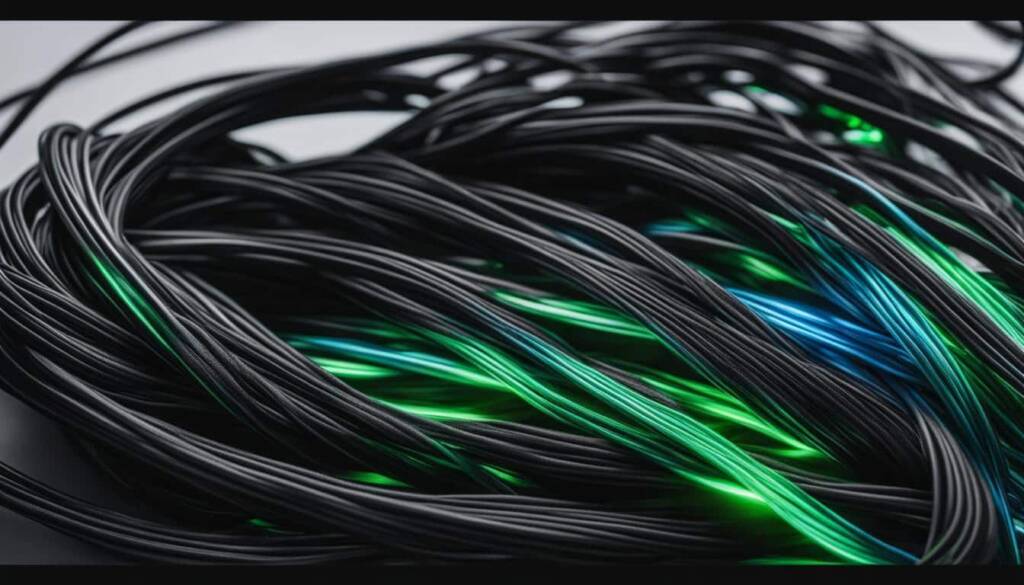Table of Contents
In today’s digital age, where high-definition video and audio are the norm, a reliable audiovisual connection is essential for delivering an immersive entertainment experience. This is where HDMI, which stands for High-Definition Multimedia Interface, comes into play. HDMI is a standard for transmitting high-quality audio and video signals, revolutionizing the way we connect our devices and enjoy our favourite content.
HDMI was developed in 2002 by Hitachi, Matsushita, and Sony as a superior alternative to analog audio/video cables. Since its inception, HDMI has become the go-to connectivity option for a wide range of devices, including TVs, game consoles, Blu-ray players, projectors, cameras, and more.
One of the key advantages of HDMI is its versatility. HDMI cables come in different types, including Type A, Type B, Type C, and Type D, allowing for seamless connectivity across various devices. Whether you’re connecting your TV to a gaming console or your camera to a projector, there’s an HDMI cable designed for your specific needs.
But what sets HDMI apart from other connectivity options? HDMI cables provide a digital connection, which means they can transmit high-definition video and audio signals without any loss in quality. This results in a crystal-clear picture and immersive sound that greatly enhances your audiovisual experience.
Additionally, HDMI cables offer several practical benefits. They are a single cable solution, reducing cord clutter and simplifying setup. HDMI is also backward-compatible with analog connections, ensuring that older devices can seamlessly connect to newer ones without the need for adapters or converters.
Whether you’re a movie enthusiast looking for a cinematic experience at home or a gamer seeking high-definition visuals with immersive sound, HDMI is the key to unlocking the full potential of your audiovisual devices. With its support for a wide range of resolutions, frame rates, and audio formats, HDMI guarantees an unparalleled audiovisual experience that will leave you amazed.
Types of HDMI Connector Cables
When it comes to HDMI connector cables, there are several types to choose from, each designed to suit different devices and purposes. Understanding the differences between these cable types can help you make the right choice for your audiovisual setup.
Here are the four main types of HDMI connector cables:
- Type A: Type A HDMI cables are the most common and widely used. They feature a standard-sized connector that is compatible with most devices such as TVs, laptops, and game consoles. With its robust design and maximum compatibility, Type A cables are the go-to choice for many audio and video setups.
- Type B: Type B HDMI cables, on the other hand, are less common and feature a larger connector with additional pins. They are primarily used for carrying dual-link DVD-I video signals. If you have a device that requires a Type B HDMI connection, you will need to ensure compatibility.
- Type C: Also known as Mini HDMI, Type C cables are smaller in size. These cables are commonly used with devices that have limited space, such as cameras, tablets, and some laptops. If you have a device with a Mini HDMI port, you’ll need a Type C cable to connect it to your display or other audiovisual equipment.
- Type D: Finally, Type D HDMI cables, known as Micro HDMI, are even smaller than Type C cables. These compact cables are commonly found on smartphones and other small electronic devices. If you have a smartphone or similar device that requires a Type D HDMI connection, you’ll need a Micro HDMI cable to connect it to compatible displays or other audiovisual equipment.
It’s important to note that each type of HDMI cable serves different purposes and is designed to fit specific devices. So, when choosing an HDMI cable, make sure to consider your device’s port and the type of connection it requires.
Benefits of HDMI
HDMI (High-Definition Multimedia Interface) offers numerous benefits as a digital connection. It serves as a reliable conduit for transmitting high-definition video and audio signals, delivering an unparalleled audiovisual experience. Compared to other types of cables, HDMI ensures a clearer picture and better sound quality, enhancing the overall multimedia experience for users.
One of the key advantages of HDMI is its simplicity. With HDMI cables, you only need a single cable to handle both high-definition video and audio signals, eliminating the need for multiple cords and reducing clutter. This streamlined setup not only saves space but also makes it easier to connect your devices and set up your entertainment system.
Another noteworthy benefit of HDMI is its backward compatibility with analog connections. This means that older devices with analog outputs can seamlessly connect to newer devices equipped with HDMI inputs without the need for additional adapters or converters. This flexibility allows users to enjoy the benefits of HDMI technology while still being able to utilize their existing devices.
“HDMI simplifies connectivity and improves the audiovisual experience, making it the go-to choice for gamers, home theater enthusiasts, and professionals.” – Sarah Thompson, Tech Expert.
HDMI’s versatility extends to its widespread use in gaming systems. HDMI cables can carry high-definition video and audio signals over a single cable, minimizing clutter and eliminating the need for separate audio and video cables. Whether you’re playing console games or PC games, HDMI ensures a smooth and immersive gaming experience with high-resolution visuals and immersive sound.
Theatrical experience at home
With HDMI, you can bring the theatrical experience to the comfort of your own home. By connecting your Blu-ray player or streaming device to your high-definition TV using HDMI, you can enjoy stunning visuals and immersive sound that rival the quality of a movie theater. HDMI’s ability to transmit high-quality audio signals, such as Dolby Atmos and DTS:X, allows you to experience movies and TV shows as they were intended to be heard.
Overall, HDMI’s digital connection, support for high-definition video and audio signals, and compatibility with various devices make it an indispensable technology for modern audiovisual experiences. Whether you’re a gamer, a movie enthusiast, or a professional in need of seamless connectivity, HDMI is the standard that delivers exceptional performance and convenience.
| Benefits of HDMI | Description |
|---|---|
| High-definition video and audio | HDMI ensures a clearer picture and better sound quality compared to other cables. |
| Single cable solution | HDMI eliminates the need for multiple cords, reducing clutter and simplifying setup. |
| Backward compatibility | HDMI cables are compatible with both analog and digital connections, allowing older devices to connect to newer ones without adapters. |
| Gaming convenience | HDMI carries high-definition video and audio signals over a single cable, making it ideal for gaming systems. |
| Theatrical experience at home | HDMI enables immersive visuals and sound, bringing the cinematic experience to your living room. |
Formats and Devices HDMI Supports
Formats and Devices HDMI Supports
HDMI is a versatile technology that supports a wide range of resolutions and frame rates, making it compatible with various display options. Whether you’re enjoying content in HD, 4K, 8K, or even the cutting-edge 10K, HDMI ensures that you get the best visual experience. No matter the level of detail or clarity you desire, HDMI has you covered.
Not only does HDMI excel in delivering impressive visuals, but it also caters to your audio needs. By supporting various audio formats like PCM, Dolby Digital, and DTS channels, HDMI brings your entertainment to life with immersive multichannel surround sound. Whether you’re watching a movie, playing games, or streaming music, HDMI ensures that the audio complements the exceptional video quality.
One of the great advantages of HDMI is its widespread adoption across a wide range of devices. From televisions and smart TV devices to laptops, game consoles, tablets, and cameras, HDMI is a standard feature in many electronic devices. This ubiquity ensures seamless connectivity and compatibility, allowing you to effortlessly connect and enjoy high-quality audiovisual experiences across multiple devices.
FAQ
What does HDMI stand for?
HDMI stands for High-Definition Multimedia Interface.
When was HDMI developed?
HDMI was developed in 2002.
Who developed HDMI?
HDMI was developed by Hitachi, Matsushita, and Sony.
What are the different types of HDMI connector cables?
There are four main types of HDMI connector cables: Type A, Type B, Type C, and Type D.
What devices are Type A HDMI cables used for?
Type A HDMI cables are used for most devices such as TVs, laptops, and game consoles.
What are the other types of HDMI cables used for?
Type B HDMI cables are used for carrying dual-link DVD-I video, Type C (Mini HDMI) cables are smaller and used for devices with limited space like cameras and tablets, and Type D (Micro HDMI) cables are even smaller and found on compact devices like smartphones.
What are the benefits of HDMI?
HDMI can transmit high-definition video and audio signals, offers a clearer picture and better sound quality, reduces cord clutter, simplifies setup, and is backward-compatible with analog connections.
What resolutions and frame rates does HDMI support?
HDMI supports a wide range of resolutions and frame rates, including HD, 4K, 8K, and 10K.
What audio formats does HDMI support?
HDMI supports various audio formats such as PCM, Dolby Digital, and DTS channels, allowing for multichannel surround sound.
What devices use HDMI cables?
HDMI cables are used in a variety of devices, including televisions, smart TV devices, laptops, game consoles, tablets, and cameras.
Is the HDMI port a standard feature in electronic devices?
Yes, the HDMI port has become a standard feature in many electronic devices, enabling seamless connectivity and high-quality audiovisual experiences.












